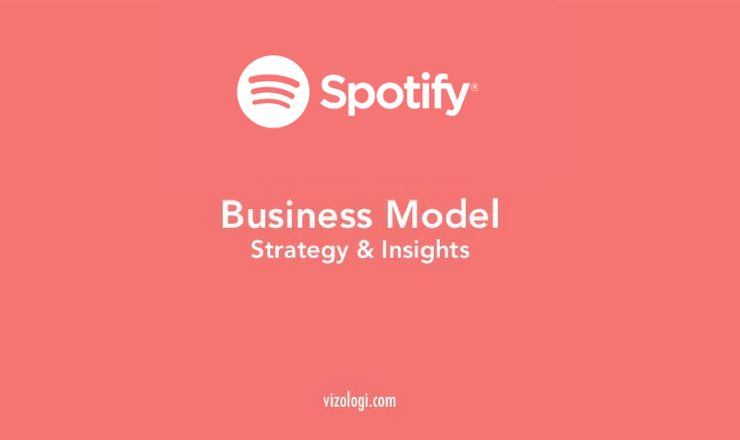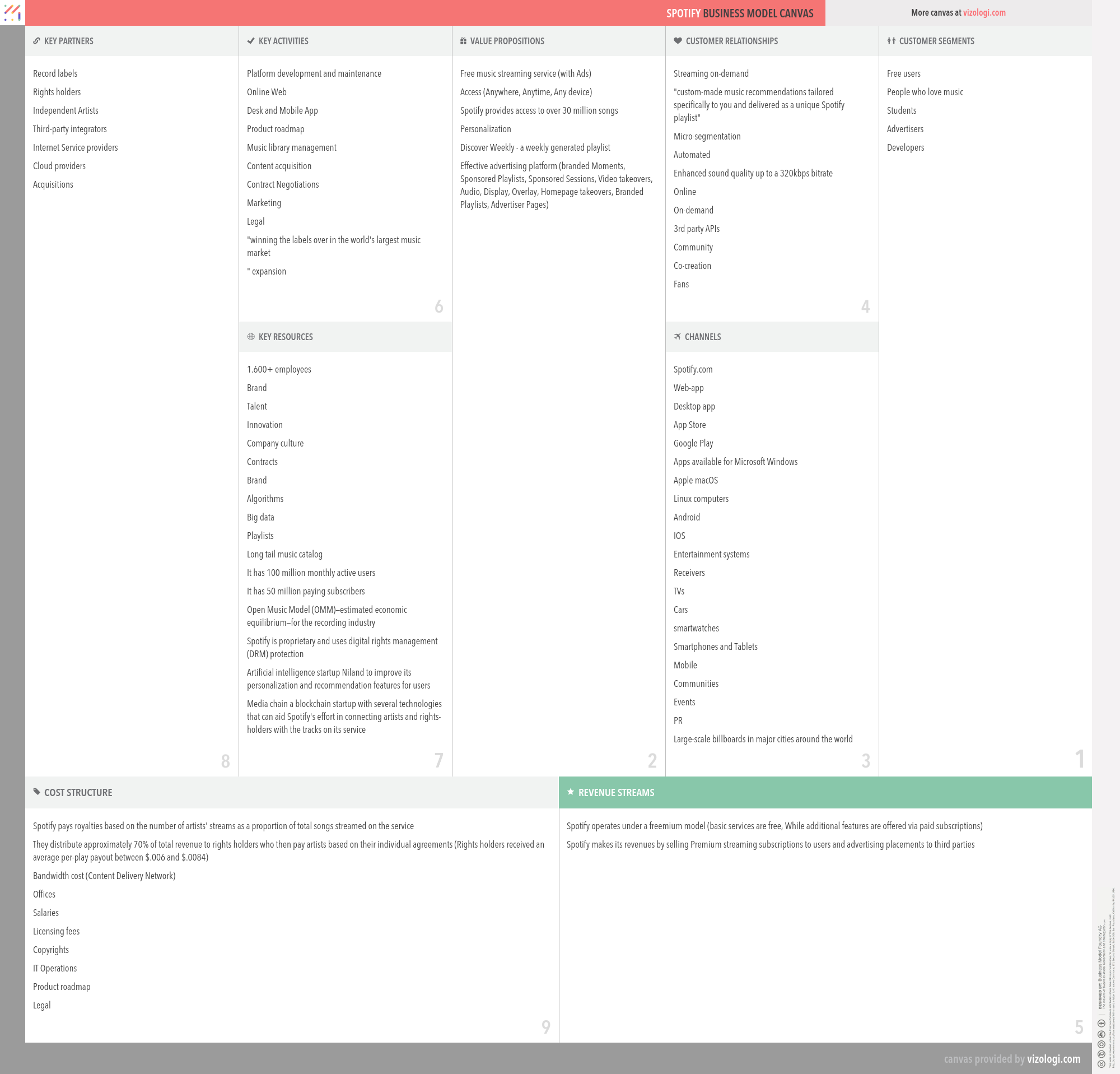SPOTIFY BUSINESS MODEL | HOW DOES SPOTIFY MAKE MONEY | STRATEGY AND INSIGHTS
Humans love music. Growth in modern technology has changed how we listen to music. Now, we use our mobile phones, MP3 players, computers, and laptops to listen to music. This has given rise to the development of many websites, applications, and software to enhance this experience. One of the best websites out there, with over 140 million active users, is Spotify. Spotify is a service that allows one to stream music, videos, and podcasts online through their website or their software application.
Spotify started its journey in 2006. It was founded by Daniel Ek and Martin Lorentzon at Spotify AB, where they were a team. Daniel Ek was the CTO for Stardoll, while Martin co-founded TradeDoubler. The application went live for the public on 7 October 2008. During the initial launch, only paid accounts were open for everyone. Free accounts were available only by invitation. Simultaneously, Spotify AB started making deals with major labels. But 2008 was not a good year for the company. They faced a loss of $4.4 million. They then decided to open up free accounts for people in the UK on 10 February 2009, but had to soon return to an invitation policy due to the rapid growth in registrations. Now Spotify is a SAAS, which is what is called a freemium service.
What is Spotify?
Spotify allows you to stream music, videos and podcasts for no charge on almost any operating system out there. Although it is a free service, there are certain limitations to the free subscription. So, there is a premium version to this service that unlocks the constraints and gives you the full-blown experience of this service. Spotify offers its users an excellent experience of listening to and sharing music with friends and family. They give out a weekly Discover playlist, where, according to your preferred songs, every Monday, they will make a playlist for you and show it to you at the top of your lists. You can share links of songs on Spotify with your friends on other social and messaging platforms. Apart from this, Spotify displays the lyrics of the music you are listening to in the app. You can also know the story behind the lyrics and the song. Spotify Radio is a setup that is perfect for listening to your favorite music in a random mood. You can filter the station to the type of song, playlist, or artist you want to listen to. You can even make Spotify your one music player for all your music. It lets you import music from your device and listen to it on the app. It also enables you to sort out how you want your music. You can filter your searches to make them more accurate. They have a Concerts feature that finds for you shows nearby, according to what kind of music you love listening to.
Exploring the Business Model Canvas of Spotify.
Spotify’s business model is really simple to understand. Even though it is simple, it works really well for the company. Let us take a look at that.
How does Spotify earn a revenue?
Spotify makes money like most other freemium services. It mainly earns from two sources: premium subscriptions and advertisements.
Advertisements
Spotify gets a lot of users because of the value it provides. Due to the type of service it is, users tend to spend a lot of time on it. This kind of application and website draws a lot of attention to the advertising cause of the many views they will get for their advertisement. Spotify relies on traditional banner-type ads and uses audio advertisements to target its vast user base. Sponsored playlists are what allow brands to sponsor a playlist for a week. Sponsored Sessions let brands connect with their audience for an uninterrupted session of listening to music. Spotify has Audio Ads that play every 15 minutes and last about 30 seconds between songs. Display Ads are displayed at the bottom of the app for 30 seconds. Homepage Takeovers are interactive skins in the background and take the homepage of Spotify. Branded Playlists are for brands that can put up a playlist for users to listen to. Video Takeovers are available for computer apps to show between songs. Advertisers and brands pay Spotify money to host their content. There are so many ways by which they can advertise their brand. Spotify has done amazingly well in this aspect. They have given so many options to brands that more can invest in their schemes.
Premium Subscriptions
Spotify has premium accounts for users to subscribe to to unlock certain features they would not get otherwise. They offer a 30-day free trial for users to test this premium service. Spotify charges $9.99 per month to get their users to test it. With Spotify Premium, listening to music becomes ad-free; you can play your music without an internet connection. You can use Connect to play music on your speakers, car, and TV. It unlocks HD music for you as well. To have the best Spotify experience, one must subscribe to the premium version of the software. Spotify Family is when an entire family gets the premium service as a package. They all must put in the same address and then join. They are allowed to have their separate playlists and everything. Such premium features draw many people to opt for it once they have tried it.
Business Model Canvas of Spotify.
Business model canvas of Spotify explains the different aspects of a business model like customer segments, value propositions, channels, customer relations, revenue stream, key activities, key resources, key partners and cost structure.
Click the image to enlarge.
Customer Segments: What is the type audience they target?
- People who don’t like to pay for services.
- Lovers of all kinds of music.
- People studying.
- Advertisers, due to all the attention the site gets.
- Developers that want to get themselves out there.
Value Propositions: What does Spotify have in store for their users.
- Practically free music anywhere, anytime.
- A massive storage of songs.
- A personal touch to the experience.
- Playlists and selected choices of liked music.
- Different forms of advertisements.
Channels: How does Spotify reach out to its customers.
- The website: Spotify.com
- The web, mobile and desktop apps.
- Available on almost all operating systems.
- Can connect it from one system to the other and to external equipment like speakers, smartwatches, and tabs.
- Can play it on TV even.
- Spotify Family lets an entire family use Spotify with one payment.
- The growing community of Spotify.
- It notifies you of events you might like around you.
- Uses billboards around major cities in the world.
Customer Relationships: What does Spotify do to maintain relationships with its customers.
- The streaming is always online and available.
- Special Spotify playlists that are customized to your liking.
- The app is user-friendly and automated.
- The HD sound quality of the music.
- Third-party APIs.
- The Spotify community.
- The fanbase of the service makes the network.
Revenue Stream: How does Spotify earn revenue.
- Spotify uses a freemium business model and earns revenue through paid subscriptions of users who wish to upgrade to a premium version.
- The other major revenue stream is the advertisers that pay Spotify to host their ads.
Key Activities: What are the activities done by Spotify.
- Maintaining the site.
- Developing the app on various platforms.
- The roadmap for the product.
- Managing the huge library they have.
- Marketing their product and what it offers.
- Expanding their user base.
- Negotiating for new contracts.
- Content acquisitions.
Key Resources: What is making Spotify a success.
- It has over 1600 employees.
- The brand name it has made for itself.
- The new innovative updates they keep making.
- The progressive culture in the company.
- The huge music collection it has.
- The various contracts they have.
- The features they offer to their users.
- The 100 million monthly active users.
- And the 50 million paying subscribers.
- The Open Music Model it adops.
- The right protection system it offers.
- The customized content it gives its users.
Key Partners: Partners that help Spotify.
- Record labels
- Rights holders
- Independent artists
- Third party integrations
- Internet services products
- Cloud providers
- Acquisitions
Cost Structures: What are the different kinds of costs that Spotify incurs?
- Offices
- Salaries
- Licensing fees
- Copyrights
- IT operations
- Product roadmap
- Legal
The Future of Spotify
Spotify is currently the leader in the online music streaming industry. Its biggest rival Apple Music has 30 million paying users while Spotify has 50 million. Its other rivals are not even close. So Spotify is leading the future of the music streaming industry. In the past weeks, Spotify announced that it might be going public and listing its shares in the New York Stock Exchange. But even though all of this is there, Spotify fails to earn much profit from its operations because they have to pay for licensing to record labels. This is impeding their growth majorly.
How will Spotify use blockchain technology?
Recently, Spotify acquired Mediachain Labs, a startup based in Brooklyn. They will help Spotify with paying artists and rights holders. They will connect the artists to the tracks on Spotify. This company is an expert in blockchain technology. This will, to some extent, solve Spotify’s problem with royalties. Mediachain Labs will manage the different tracks of the novel ones and their owners. They will keep track of who has to get paid and how much. This all eased out the staff’s working and cut their outgoing costs. However, even with all of these changes, they’ve to devise a way to make significant profits from their services to survive in the long run. If they figure this out, they can become a profit-making giant.

Vizologi is a revolutionary AI-generated business strategy tool that offers its users access to advanced features to create and refine start-up ideas quickly.
It generates limitless business ideas, gains insights on markets and competitors, and automates business plan creation.




